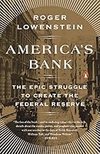
Saved by Jakob Linder and
America's Bank

Saved by Jakob Linder and
The key problem that Warburg outlined was the lack of a central reserve. In effect, each of the country’s approximately fifteen thousand banks stood watch over its own cache of gold, which neutralized what could have been a potent collective reserve. Another problem was the lack of a liquid market in so-called bills of trade—pieces of paper
... See moreNonetheless, the Reserve Banks were permitted to conduct open market operations such as buying bonds, later to become a favorite tool of Ben Bernanke.
“It’s your duty to put your ideas before the country.”
It is a truism of capitalism that if money is injected into the system, no matter the intent, some of it will end up benefiting well-connected financiers.
onlooker in 1913 could have predicted that one day the Fed’s most well-advertised duty would be setting interest rates. The bill’s primary purpose was to mobilize reserves, the better to avert a crisis, and to modernize the banking system.
By giving banks an incentive to invest in government debt, the United States contrived a means of financing the war.
But for political reasons, as well as the desire to inflate their own roles, Glass and Willis each felt compelled to disown the connection to Aldrich.
The lack of “stability” in the currency, the want of flexibility for “needful expansion,” suggested a profound inadequacy in the system.
As a practical matter, bankers were correct that the bimetallic system of gold and silver was inherently unstable, since people would seek to cash in the poorer coin (in this case, the silver) for the richer one. But the gold standard imposed severe hardships on a great many Americans. In plain terms, the production of gold was not sufficient to
... See more